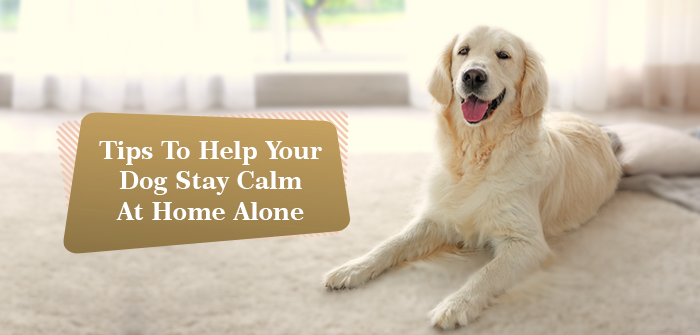Tips To Help Your Dog Stay Calm At Home Alone

During the coronavirus quarantine, did you get a new dog? Or has your long-term four-legged partner become habituated to your presence?
Dogs are highly social animals, which is why we get along so well with them. If the pups suddenly switch from ‘everyone home all the time to ‘nobody home all day,’ it might cause major behavioral issues. This can lead to house mishaps, chewing on the furniture while you’re away, or even worse.
Do you want to prevent it? For both you and your four-legged partner, here’s how to make the move to a new normal.
Before you walk outdoors alone, there are a few things you can do to help your four-legged pals stay relaxed and quiet at home alone. These tips will assist your dog to adapt from lockdown to normal life, whether it’s a new or old dog. Read on!
Safety
Obviously, the main priority is safety. If your dog is injured, he will be upset. So make sure your dog can’t chew on cords, drink toxic chemicals (like bleach or antifreeze), or get into anything else that could damage him. Depending on your dog’s age and preferences, you may want to crate them or limit them to a mudroom or laundry room while you’re not in the home.
A note about crates: they may make your dog feel even more confined, causing him to run wild when you let him out —If this describes your dog, a crate might not be the best solution.
Physical Exercise
While every dog requires exercise, some dogs require a LOT of it. Lab puppies and Border collies are two examples of high-energy breeds. They will require a daily positive outlet for their energy, or they will find it on their own. This could entail taking them for a one-hour walk before leaving for work and another one-hour walk when you come home. Hiring a midday dog walker to assist both you and your pup can also help you keep your sanity.
Mental Exercise
Interactive puzzle games, peanut butter-stuffed Kongs, or other appropriate chew toys will keep your dog occupied rather than looking for other sources of entertainment. You can also experiment with different toys to find which ones your dog prefers.
Use a Monitor
There are several webcam solutions for keeping an eye on your dog while you’re away. Specific types of equipments designed for this purpose are available, as well as configuring Skype on a home computer to see (and chat to) your dog. This will allow you to monitor your dog’s progress and, if a problem arises, you can enlist the assistance of an emergency contact.
Recognize the Symptoms of Frustration or Separation Anxiety
There’s boredom, and then there’s concern over being separated. If you’ve followed the steps above, including making sure your dog gets an additional hour of activity every day, and he’s still unhappy, you may need expert help to work with you because the situation can be complex.
When left alone, dogs with separation anxiety will bark or whine for long periods of time. Another indicator of separation anxiety is frequent destruction. If you feel your dog is worried, consult your veterinarian and try several tried-and-true anxiety control products for dogs, such as Adaptil Spray, Adaptil Collar, or Adaptil Diffuser.
“Dogs bring us a tremendous amount of happiness. We owe them our attention in exchange for all of theirs”
Bottom Line:
Your four-legged partner should quickly acclimatize to being left alone while you are at work if you use these basic tactics. These tiny joys are extremely adaptive, and they generally accept their daily routines without complaint. As long as you provide your furry friend with something to do, chew on, and a comfortable place to sleep, he should be at ease to have the house to him.

